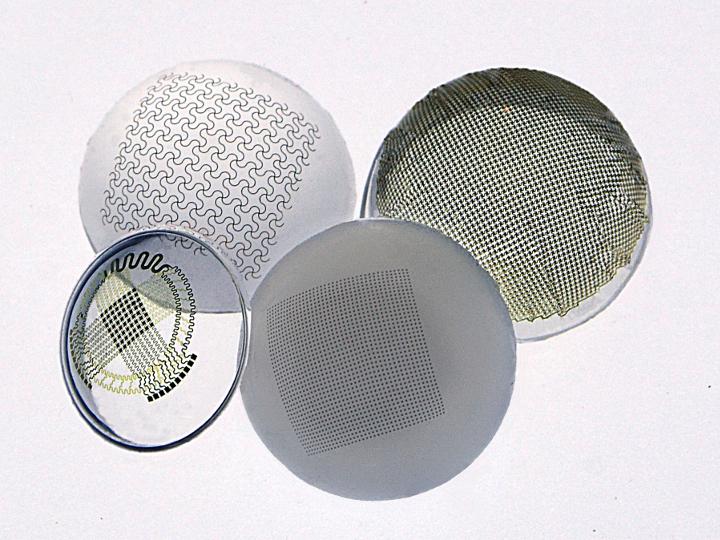Researchers report a new way to produce curvy electronics

A team of researchers led by University of Houston engineer Cunjiang Yu has reported a new way to manufacture curvy, three-dimensional electronics. Credit: University of Houston
Contact lenses that can monitor your health as well as correct your eyesight aren't science fiction, but an efficient manufacturing method – finding a way to produce the curved lenses with embedded electronics – has remained elusive.
Until now. A team of researchers from the University of Houston and the University of Colorado Boulder has reported developing a new manufacturing method, known as conformal additive stamp printing, or CAS printing, to produce the lenses, solar cells and other three-dimensional curvy electronics.
The work, reported in the journal Nature Electronics, demonstrates the use of the manufacturing technique to produce a number of curvy devices not suited to current production methods. The work is also highlighted by the journal Nature.
“We tested a number of existing techniques to see if they were appropriate for manufacturing curvy electronics,” said Cunjiang Yu, Bill D. Cook Associate Professor of Mechanical Engineering at the University of Houston and corresponding author on the paper. “The answer is no. They all had limitations and problems.”
Instead, Yu, who is also a principal investigator with the Texas Center for Superconductivity at UH, and his team devised a new method, which they report opens the door to the efficient production of a range of curvy electronic devices, from wearables to optoelectronics, telecommunications and biomedical applications.
“Electronic devices are typically manufactured in planar layouts, but many emerging applications, from optoelectronics to wearables, require three-dimensional curvy structures,” the researchers wrote. “However, the fabrication of such structures has proved challenging due, in particular, to the lack of an effective manufacturing technology.”
Existing manufacturing technologies, including microfabrication, don't work for curved, three-dimensional electronics because they are inherently designed to produce two-dimensional, flat electronic devices, Yu said. But increasingly, there is a need for electronic devices that require curvy, 3-D shapes, including smart contact lenses, curved imagers, electronic antennas and hemispherical solar cells, among other devices.
These devices are small – ranging in size from millimeters to centimeters – with accuracy within a few microns.
Recognizing that, Yu and the other researchers proposed the new fabrication method, conformal additive stamp printing, or CAS printing.
CAS printing works like this: An elastomeric, or stretchy, balloon is inflated and coated with a sticky substance. It is then used as a stamping medium, pushing down on pre-fabricated electronic devices to pick up the electronics and then print them onto various curvy surfaces. In the paper, the researchers describe using the method to create a variety of curvy devices, including silicon pellets, photodetector arrays, small antennas, hemispherical solar cells and smart contact lenses.
The work was performed using a manual version of the CAS printer, although the researchers also designed an automated version. Yu said that will make it easy to scale up production.
###
In addition to Yu, co-authors include Kyoseung Sim, Song Chen, Zhoulyu Rao, Jingshen Liu, Yuntao Lu, Seonmin Jang, Faheem Ershad and Ji Chen, all with UH, and Zhengwei Li and Jianliang Xiao, both with the University of Colorado Boulder.
This work was supported by National Science Foundation.
Media Contact
All latest news from the category: Power and Electrical Engineering
This topic covers issues related to energy generation, conversion, transportation and consumption and how the industry is addressing the challenge of energy efficiency in general.
innovations-report provides in-depth and informative reports and articles on subjects ranging from wind energy, fuel cell technology, solar energy, geothermal energy, petroleum, gas, nuclear engineering, alternative energy and energy efficiency to fusion, hydrogen and superconductor technologies.
Newest articles

NASA: Mystery of life’s handedness deepens
The mystery of why life uses molecules with specific orientations has deepened with a NASA-funded discovery that RNA — a key molecule thought to have potentially held the instructions for…

What are the effects of historic lithium mining on water quality?
Study reveals low levels of common contaminants but high levels of other elements in waters associated with an abandoned lithium mine. Lithium ore and mining waste from a historic lithium…

Quantum-inspired design boosts efficiency of heat-to-electricity conversion
Rice engineers take unconventional route to improving thermophotovoltaic systems. Researchers at Rice University have found a new way to improve a key element of thermophotovoltaic (TPV) systems, which convert heat…



